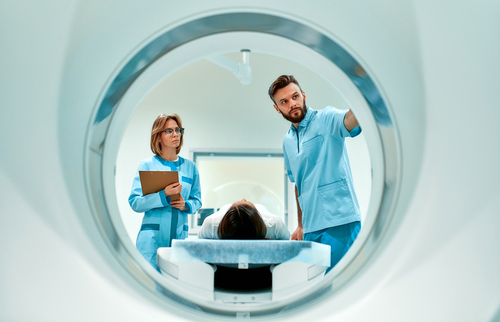
Diagnosing early-stage lung cancer with low-dose computed tomography (CT) screening has shown significantly improved cure rates. The initial results of the Early Lung Cancer Action Program (ELCAP) in 1999 provided evidence supporting the benefit of annual low-dose CT for lung cancer in high-risk individuals. The study found that 85% of individuals with newly diagnosed lung cancer with low-dose CT had stage I lung cancer, while 82% of these low-dose CT-detected stage I cancers had not been identified on chest radiographs obtained at the same time as the low-dose CT scans.
This finding led to the International ELCAP (I-ELCAP) collaboration that enrolled 31,567 participants in annual low-dose CT screening between 1992 and 2005. In 2006, the I-ELCAP investigators reported the 10-year Kaplan-Meier lung cancer-specific survival of 80% for 484 participants diagnosed with a first primary lung cancer through CT screening.
In a new study, I-ELCAP investigator Claudia Henschke, PhD, MD, and colleagues looked at the 20-year survival rates in the expanded I-ELCAP cohort. “Lung cancer cure rates achieved in screening programs have received increased attention as low-dose CT screening has begun to be implemented globally. For lung cancer, the consensus is that the survival curve plateau for estimating the cure is reached 8 to 10 years after treatment. To the best of our knowledge, no other studies have reported 20-year lung cancer-specific survival for low-dose CT screening programs,” said the researchers. Their findings were reported in Radiology [2023;309(2):e231988].
I-ELCAP is a prospective, multicenter, ongoing screening program. A total of 89,404 participants underwent cancer screening between 1992 and 2022. Of that population, 1257 participants were diagnosed with first primary lung cancer through annual low-dose CT screening. All participants were aged 40 years and older and had current or former cigarette use or had never smoked but were exposed to secondhand smoke. Of the cohort, 684 were men and 573 were women.
At the time of diagnosis, the median age of participants was 66 years, with a median smoking history of 43 pack-years. The majority (67.1%) of participants had adenocarcinoma followed by squamous cell carcinoma (13.4%). The median follow-up duration was 105 months. The frequency of clinical stage I disease at pretreatment was 81%. Kaplan-Meier survival analysis was used to calculate 10- and 20-year lung cancer-specific survival rates through annual screening.
The findings underscored the importance of low-dose CT screening for the early intervention of lung cancer. Among the 1257 participants, the 10-year lung cancer-specific survival rate was 81% (95% CI, 79%-84%) and the 20-year survival rate was 81% (95% CI, 78%-83%). “To reach this high cure rate of 80%, however, requires that low-dose CT screening follows a well-defined, regularly updated protocol for the workup of CT findings, a comprehensive data management system for the entire screening program, and training to ensure appropriate follow-up and adherence to continued annual screening,” noted the authors.
For the 1017 participants with stage I clinical cancer, the 20-year lung cancer-specific survival rate was 87% (95% CI, 85%-89%), while for the 930 participants with stage I lung cancer defined by the hybrid definition of stage I disease (pathologic stage if resected, clinical stage if not resected) it was 87% (95% CI, 85%-89%). After 10 years of follow-up, the Kaplan-Meier survival plateau was reached. When the researchers excluded 22 adenocarcinoma in situ and minimally invasive adenocarcinoma cases, the 20-year survival for the remaining 1235 participants was 80% (95% CI, 78%-83%). In the 998 participants who had surgical resection, 20-year survival was 87% (95% CI, 85%-90%). In the subset of 181 participants diagnosed with the earliest stage I disease (≤10 mm), it was 95% (95% CI, 91%-98%).
The participants were also separated into three categories of smoking. The 20-year survival for each category of cigarette smoking was 85% (95% CI, 78%-91%) among 136 participants who had a smoking history of less than 10 pack-years, including those who had never smoked cigarettes but had passive exposure to cigarette smoke; 83% (95% CI, 77%-89%) in 196 participants with a smoking history of 10 to 29 pack-years; and 79% (95% CI, 77%-82%) in 925 participants with a smoking history of at least 30 pack-years (P=.26). After adjusting for sex and age, the researchers observed no difference in the risk of lung cancer death among participants who had smoked for at least 30 pack-years compared with participants who had a smoking history of less than 10 pack-years, including those who had never smoked (hazard ratio [HR], 1.2; 95% CI, 0.65-2.17; P=.59) and participants who had smoked for 10 to 29 pack-years (HR, 1.3; 95% CI, 0.82-2.22; P=.25).
The researchers acknowledged several study limitations. A limitation of long-term follow-up is that advances in CT and positron emission tomography technology, as well as other diagnostic treatment modalities that improve outcomes, are not fully recognized. Staging has changed from the sixth edition to the eighth edition of the TNM staging system for lung cancer. Compliance with the annual screening protocol was variable among the institutions. Of the 1257 participants with lung cancer, only 556 had more than 10 years of follow-up data, which might have affected the survival outcomes.
In conclusion, the researchers stated, “Future focus should be on identifying lung cancer even earlier, perhaps during the first 20 doublings rather than the last 20 doublings, as can currently be achieved using low-dose CT. Blood biomarkers and new imaging tests will continue to improve. We eagerly await new innovations that can be rapidly evaluated by comparison with low-dose CT using the ELCAP approach.”







 © 2025 Mashup Media, LLC, a Formedics Property. All Rights Reserved.
© 2025 Mashup Media, LLC, a Formedics Property. All Rights Reserved.